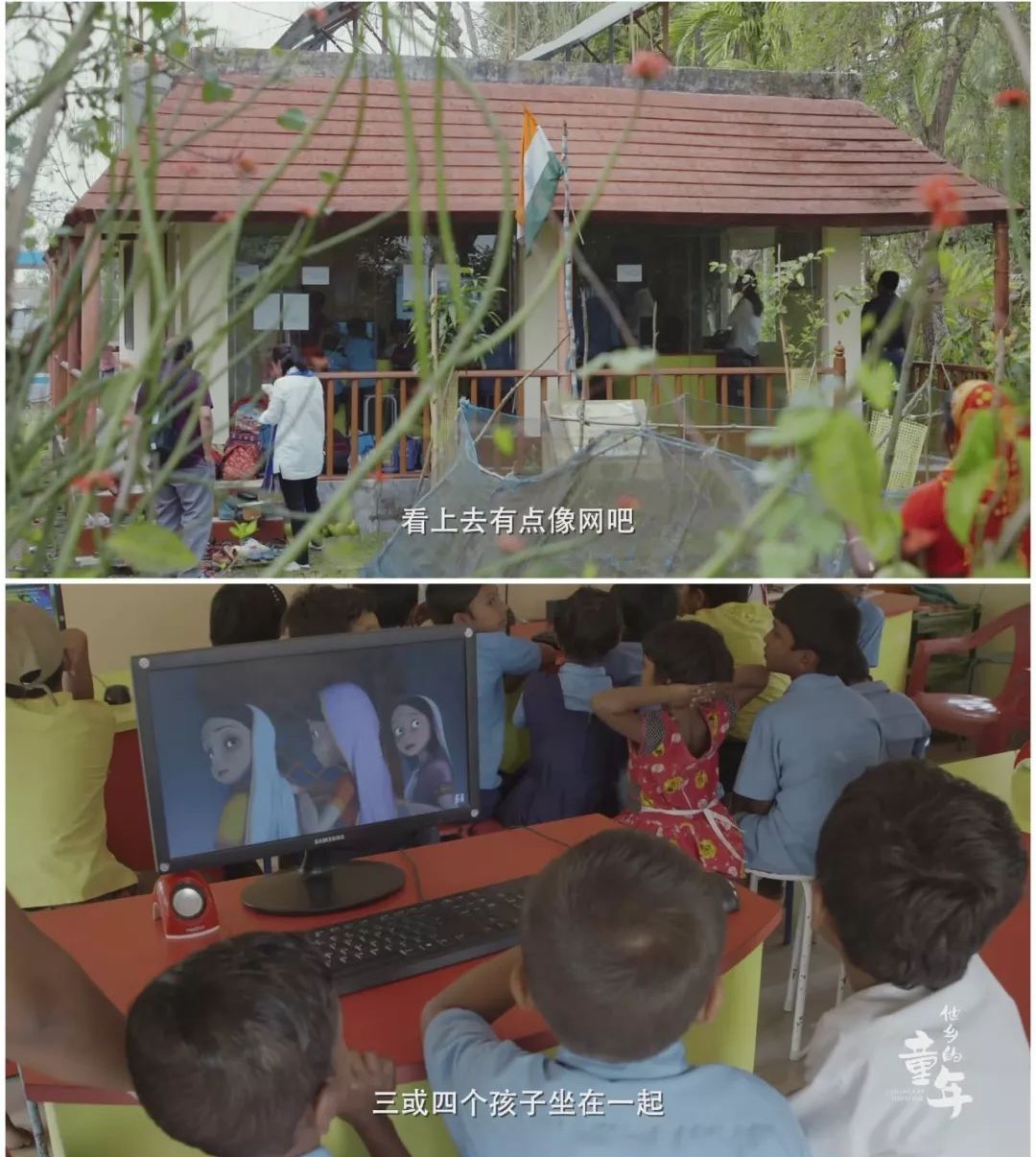With. Teachers in India said frankly, “Computers are already a part of the lives of this generation of children. You need to make them realize how to use computers in the best way, whether it is a book or the Internet, and learn to use resources.”

documentary “Other Township” Cloud School in Childhood “
Monica, who is in charge of Chinese teaching in the middle school at an international school in India, has been from China to India for half a year. She told Zinc Scale, “Indian students are deeply troubled by high housing prices, severe employment situation, and the caste system that lasts for thousands of years, and the uneven distribution of educational resources is very serious.”
Monica found that although India and China implement free and compulsory education, the education system is also divided into a public school system and a private education system. However, public schools in India lack teachers, have chaotic management, and have poor teaching equipment. Therefore, many Indian families even put their children in private schools in order to send their children to private schools.
“This is also the importance of online education in India. Access to educational resources to break down the class has become the reason why Indian students, including adults, choose online education, which is low cost and convenient.” Monica said that in her school, In addition to students, many teachers and parents of students, in order to take various civil service, engineering and medical examinations, have been studying related courses through online education platforms in recent years.
Policy guidance also plays an important role. Earlier, the Indian government put forward the concept of “Digital India” and proposed specific actions for e-education. First, all schools access broadband; second, all schools provide free wifi; third, open digital literacy; fourth, apply MOOC, develop Large-scale online open courses.
Under the government’s attention, India’s online education market has released huge potential. According to the 2016 report of the well-known Indian management consulting company Technopak, the 2016 Indian education market totaled 100 billion US dollars. Affected by the rapid expansion of the digital learning market and the world ’s largest population of 6-17 years old, the Indian education market will be in 2020. This increased to US $ 180 billion, almost double that of 2016.
The continued optimism of capital has catalyzed the further development of online education in India. According to the Economic Times, the Indian education technology market has attracted a total of US $ 1.5 billion, and institutions including Facebook, Tiger Global, Matrix Partners and GGV Capital have at leastHave invested in an Indian education technology company.
According to a KPMG report, India ’s online learning market will grow 42% by 2021, and the market size will reach $ 29 million. The report pointed out that “English learners are the main promoters of online language learning.”
Chinese companies are rushing into the “Nuggets”
“Brother, Rohit teased me in front of girls. I can’t speak English. This is the most important war in my life. I can’t speak English at all.” In front of the camera, an Indian boy in school uniform Friends complained.
At this time, the boy named Rohit came over, took out his mobile phone, and showed him the secret weapon of learning English on the mobile phone-Netease Youdao Dictionary U-Dictionary Overseas Edition.
This is one of the works of the Youdao Dictionary short video contest marketing campaign. On Youtube, there are already 3.85 million views.
This nugget of online education in India has made many Chinese education technology companies see the hope of “early moon near the water tower”. Behind this series of marketing short videos, it is the Chinese education companies that are going to India Cast your gaze.
As early as 2016, NetEase ’s Youdao Dictionary entered the Indian market through the educational tool product U-Dictionary.
“India is currently the most demographic dividend emerging sea market. The market is in a period of rapid growth, and many industries have not yet formed a stable competitive landscape. This is an important opportunity for U-Dictionary.” NetEase Youdao The person in charge told Zinc Scale that in India, quite a lot of people are desperately motivated. They need to acquire knowledge to achieve the leap, and English is one of the fastest ways. Therefore, there is a huge consumer market for English education in India. According to the user portraits provided by Youdao, half of the users are between 18-24 years old, and most of them are from third- and fourth-tier cities. They hope to learn English to get a simple job, or upgrade their skills to get more Good job opportunity. 
in the short video -Dictionary interface
“Our experience in the domestic market and the success of U-Dictionary in India have given us confidence.” The above-mentioned relevant person in charge said so.
In fact, Netease Youdao is just out this timeA little wave of the waves.
According to Zhixiang.com, many Chinese companies have recently spread news of entering the Indian online education market. Ape Counseling, YY and other companies have begun to explore the Indian market by establishing overseas teams, investing in online education institutions, or expanding their product business.
Among them, the ape counseling strategy invested in a K-12 online tutoring platform called ape seal, the investment amount has not been disclosed.
It is worth noting that according to Qixinbao ’s business information, the Indian headquarters of Ape India is located in Bangalore. One of its founders is the senior director of the Meituan Diandian business group Liu Can, and he and the team developed the product ODA Class It went online in November 2019.
The former head of gogokid, a product of byte beat benchmark VIPKID, also revealed to the media that byte beating has also made a product similar to the job gang in India. Insiders in charge of the byte-beating education business said that in the byte-beating overseas education market, India is currently doing relatively well, and the products are still incubating and have not been officially announced.
The road to sea is full of thorns
Some data and examples prove the correctness of the selection of these Chinese education companies-the local operation team of Youdao Dictionary, working in a shared office space in Delhi for 9 months, has created more than 30 million in India. User data.
Li Yong, founder of Ape Coaching, once said, “ODA Class has harvested over 1 million subscribers in 50 days, proving the possibility of team success.”
The emphasis on sinking markets is the common denominator of these education companies marching into India. It is for this reason that, although American companies were the first to reach Internet users in India, Chinese companies have quickly captured the user base of third- and fourth-tier cities in India and occupied a broader market.
But the road to sea is not as easy as expected.
In spite of the growing number of competitors, Byju ’s, India ’s homegrown online education platform, is still dominant, and companies from other overseas countries such as the United States are also pouring in. What do China’s online education teams need to face directly from this competition?

Online in India Educational platform Byju ‘s
The formation of the overseas team is a big problem. For NetEase, which requires localized operations, “In India, talent recruitment is indeed a big difficulty. The Internet talent market in India is not as mature as China, which also brings great difficulties to our localized operations. . “
The relevant person in charge of Netease Youdao told Zinc Scale, “The online education market in India and China is still very different, including cultural differences, the intricate language usage and network environment in India.”
“India is the slowest 4G country in the world, with a 4G penetration rate of only 21%, far lower than the 44% penetration rate in Asia over the same period; and the tariffs for traffic are higher than other developing countries.” It is said that the investigation team found that most users in India will uninstall the APP after using it for a period of time, because the memory of the mobile phone is small, if you want to use other APPs, you must first uninstall the previous software and download it when you use it next time, “For this reason, U -Dictionary compressed the installation package to 4M at that time, and all languages have offline word packages, which can be used and turned over, not limited by the network. “
A more serious reality is that most Chinese online education companies going to India believe that the Indian online education market is still in a very preliminary stage, and the online payment habits of locals have yet to be cultivated.
Data is more intuitive to illustrate that despite the great market potential, online education in India has not yet been able to talk about “outbreaks”. According to Inc42, the Indian education market is worth US $ 101 billion in 2019, and the online education market is worth US $ 563 million, accounting for only 0.56% of the entire industry.
“Some Indian parents, like Chinese parents, worry that their children will be exposed to electronic products and waste time playing games, which hinders the popularization of learning platforms.” Monica also told Zinc Scale that the average or lower economic level Areas, even the Internet has not been popularized, and many students and parents do not yet know the existence of online education.
It can be seen that the road to sea for Chinese education companies is still long, but under the constraints of capital chase, increased competition in the domestic market, difficulty in obtaining domestic customers, and peak flow, etc., they entered India, which is similar to China’s national conditions, and then explored a larger scale of going overseas The way is their only way.
It can be seen from the current path of these companies to enter India. With the deepening of globalization, Chinese online education companies will inevitably face many problems when going overseas. Therefore, in the process of exploring the road to the sea, relevant companies still need to think about how to improve their international competitiveness and solve the problems of localization.

According to Zhixiang.com, many Chinese companies have recently spread news of entering the Indian online education market. Ape Counseling, YY and other companies have begun to explore the Indian market by establishing overseas teams, investing in online education institutions, or expanding their product business.
Among them, the ape counseling strategy invested in a K-12 online tutoring platform called ape seal, the investment amount has not been disclosed.
It is worth noting that according to Qixinbao ’s business information, the Indian headquarters of Ape India is located in Bangalore. One of its founders is the senior director of the Meituan Diandian business group Liu Can, and he and the team developed the product ODA Class It went online in November 2019.
The former head of gogokid, a product of byte beat benchmark VIPKID, also revealed to the media that byte beating has also made a product similar to the job gang in India. Insiders in charge of the byte-beating education business said that in the byte-beating overseas education market, India is currently doing relatively well, and the products are still incubating and have not been officially announced.
The road to sea is full of thorns
Some data and examples prove the correctness of the selection of these Chinese education companies-the local operation team of Youdao Dictionary, working in a shared office space in Delhi for 9 months, has created more than 30 million in India. User data.
Li Yong, founder of Ape Coaching, once said, “ODA Class has harvested over 1 million subscribers in 50 days, proving the possibility of team success.”
The emphasis on sinking markets is the common denominator of these education companies marching into India. It is for this reason that, although American companies were the first to reach Internet users in India, Chinese companies have quickly captured the user base of third- and fourth-tier cities in India and occupied a broader market.
But the road to sea is not as easy as expected.
In spite of the growing number of competitors, Byju ’s, India ’s homegrown online education platform, is still dominant, and companies from other overseas countries such as the United States are also pouring in. What do China’s online education teams need to face directly from this competition?

Online in India Educational platform Byju ‘s
The formation of the overseas team is a big problem. For NetEase, which requires localized operations, “In India, talent recruitment is indeed a big difficulty. The Internet talent market in India is not as mature as China, which also brings great difficulties to our localized operations. . “
The relevant person in charge of Netease Youdao told Zinc Scale, “The online education market in India and China is still very different, including cultural differences, the intricate language usage and network environment in India.”
“India is the slowest 4G country in the world, with a 4G penetration rate of only 21%, far lower than the 44% penetration rate in Asia over the same period; and the tariffs for traffic are higher than other developing countries.” It is said that the investigation team found that most users in India will uninstall the APP after using it for a period of time, because the memory of the mobile phone is small, if you want to use other APPs, you must first uninstall the previous software and download it when you use it next time, “For this reason, U -Dictionary compressed the installation package to 4M at that time, and all languages have offline word packages, which can be used and turned over, not limited by the network. “
A more serious reality is that most Chinese online education companies going to India believe that the Indian online education market is still in a very preliminary stage, and the online payment habits of locals have yet to be cultivated.
Data is more intuitive to illustrate that despite the great market potential, online education in India has not yet been able to talk about “outbreaks”. According to Inc42, the Indian education market is worth US $ 101 billion in 2019, and the online education market is worth US $ 563 million, accounting for only 0.56% of the entire industry.
“Some Indian parents, like Chinese parents, worry that their children will be exposed to electronic products and waste time playing games, which hinders the popularization of learning platforms.” Monica also told Zinc Scale that the average or lower economic level Areas, even the Internet has not been popularized, and many students and parents do not yet know the existence of online education.
It can be seen that the road to sea for Chinese education companies is still long, but under the constraints of capital chase, increased competition in the domestic market, difficulty in obtaining domestic customers, and peak flow, etc., they entered India, which is similar to China’s national conditions, and then explored a larger scale of going overseas The way is their only way.
It can be seen from the current path of these companies to enter India. With the deepening of globalization, Chinese online education companies will inevitably face many problems when going overseas. Therefore, in the process of exploring the road to the sea, relevant companies still need to think about how to improve their international competitiveness and solve the problems of localization.

Data is more intuitive to illustrate that despite the great market potential, online education in India has not yet been able to talk about “outbreaks”. According to Inc42, the Indian education market is worth US $ 101 billion in 2019, and the online education market is worth US $ 563 million, accounting for only 0.56% of the entire industry.
“Some Indian parents, like Chinese parents, worry that their children will be exposed to electronic products and waste time playing games, which hinders the popularization of learning platforms.” Monica also told Zinc Scale that the average or lower economic level Areas, even the Internet has not been popularized, and many students and parents do not yet know the existence of online education.
It can be seen that the road to sea for Chinese education companies is still long, but under the constraints of capital chase, increased competition in the domestic market, difficulty in obtaining domestic customers, and peak flow, etc., they entered India, which is similar to China’s national conditions, and then explored a larger scale of going overseas The way is their only way.
It can be seen from the current path of these companies to enter India. With the deepening of globalization, Chinese online education companies will inevitably face many problems when going overseas. Therefore, in the process of exploring the road to the sea, relevant companies still need to think about how to improve their international competitiveness and solve the problems of localization.